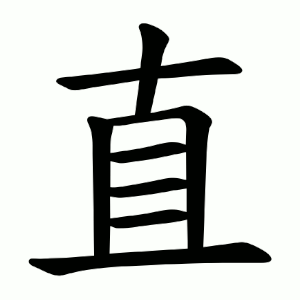直
- straight;
- upright, correct;
- honest;
Etymology
Originally a pictographic–ideographic compound:
Top part 十 + 目 (eye) – indicating “to see clearly, directly.”
Bottom part 丨 (vertical stroke) – symbolizing straightness or uprightness.
Together, the character conveys the sense of “straight/upright as seen by the eye.” Over time, it took on the broader meanings of “correct, just, honest.”
Semantic range:
- straight, not bent – 곧다.
- upright, proper, correct – 바르다, 옳다.
- frank, direct – 솔직하다.
- duty, post, shift (extended sense, as in 宿直 “night duty”).
Usage in Korean
정직(正直) – honesty, integrity.
직선(直線) – straight line.
직접(直接) – directly, in person.
당직(當直), 숙직(宿直), 하직(下直) – post/duty terms where 直 has the extended meaning of “taking a turn, being on duty.”
Words that derived from 直
- 경직(硬直)–stiffness; being stiff; rigidity; inflexibility
- 경직성(硬直性)–stiffness; rigidity; inflexibility
- 경직하다(硬直하다)–be stiff; be rigid; be formal
- 솔직히(率直히)–frankly; honestly
- 정직(正直)–honesty; integrity
- 직결(直結)–direct connection
- 직접주관권(直接主管圈)–the realm of direct dominion
- 직행(直行)–nonstop; express
- 직행버스(直行bus)–express bus; nonstop bus
直
곧을
직
godeul
jik
Kangxi radical:109, 目 + 3
Strokes:8
Unicode:U+76F4
Cangjie input:
- 十月一一 (JBMM)
Composition:
- ⿱ 十 ⿴ 𠀃 三 (G H)
- ⿱ 𠂇 ⿴ 𠀃 三 (T V)
